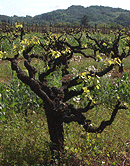|
Wineries
Wines
More Info. |

Just
a Few Interesting Facts and
Trivia... Wine... Wine is
fat-free and contains no cholesterol. A six ounce
glass of wine contains approximately 130
calories. The Pinot
Noir grape has more clones (over 100 registered)
than any other wine grape variety. California
WIne... California
has estimated 513,000 acres of wine grapes and
approximately 1,300 bricks and mortar
wineries Chardonnay is
the grape variety with the largest acreage in
California, followed by Cabernet Sauvignon, Merlot
and Zinfandel. In terms of
finished wine, Chardonnay is the leader, followed
by Merlot, White Zinfandel and Cabernet
Sauvignon. California
accounts for over 90% of total U.S. wine production
and approximately two out of every three bottles of
wine sold in the United States was produced in
California. California
had 2001 wine sales estimated at 450 million
gallons and had 2004 wine sales estimated at $15
billion. The wine industry's impact on the economy
of California is greater than $45 billion and is
responsible for over 200,000 jobs. California
has over 60,000 registered wine labels California
wine country hosted 14.8 billion visitors in 2002,
making it second only to Disneyland as California's
top tourist attraction. Laying on the
Brix. The sugar
content in grapes is measured in Brix. The degrees
of Brix of grapes is an indicator of the potential
alcohol content of the finished wine. If all the
sugars are fermented into alcohol, dividing the
Brix level in half will indicate the approximate
alcohol content of the finished wine. Two degrees
Brix results in slightly more than 1 percent
alcohol. One acre of land
averages One barrel of wine
contains One case of wine
contains One 750 ml bottle of wine
contains One 6-ounce glass of wine
contains A bottle of any
other name is... Brand The brand name is used by the
bottler to identify the product. Any brand name is
acceptable if it does not mislead the
consumer. Vintage
Date A vintage date on the label
indicates that 95% or more of the wine is
produced from grapes grown in that year. Appellation of
Origin The place in which the
dominant grapes used in the wine are grown. A
country, state or county appellation on the label
means that at least 75% of the wine is
produced from grapes grown in the place
named. American Viticultural Area
(AVA) A U.S. viticultural area is a
well-defined, registered grape-growing region with
soil, climate, and geographic features which set it
apart from the surrounding areas. A viticultural
area appellation on the label indicates that
85% or more of the wine is produced from
grapes grown in the particular area. Varietal
Designations The names of the dominant
grapes used in the wine. Cabernet Sauvignon,
Merlot, Pinot Noir and Chardonnay are examples of
grape varieties. A varietal designation on the
label means that at least 75% of that grape
variety is used in the wine. Estate
Bottled "Estate Bottled" means that
100% of the wine came from grapes grown on
land owned or controlled by the winery, located in
the viticultural area. The winery then crushes and
ferments the grapes, finishes, ages, processes and
bottles the wine in one continuous operation. In
the case where the winery and the winery's own
vineyards are not in the same viticultural area,
the winery may designate that the wine has been
"Proprietor Grown." Reserve Since the term "reserve" has no legal meaning in
the U.S., wineries may use this term to designate a
special bottling (i.e. "Show Reserve") or limited
production. In some cases a winery will use the
term as a marketing tool and has no other
meaning. |
|||||||||||||||||||||||||||||||||||||||||||||||||||||
